CARACTERIZAÇÃO COLORIMÉTRICA E ABSORBÂNCIA DE NANOFIBRAS DOS ÓXIDOS DE TITÂNIO E TUNGSTÊNIO NA REGIÃO UV-vis
DOI:
https://doi.org/10.51891/rease.v7i6.1440Keywords:
Colorimetry. Nanofibers. Titanium.Tungsten. O2 Vacancy.Abstract
Many of the properties of materials, such as optical, electrical conductivity and diffusional transport, are defined by the presence of imperfections or defects in the crystal lattice. The simplest of point defects is a vacancy or empty site in the lattice, where an atom is removed from the commonly filled site. Vacancies can arise during solidification or as a result of atomic vibrations, which cause changes in the position of atoms from their normal sites in the network. In colorimetry, the formation of point defects is essential to increase the absorption of incident light and reflect the most different colors. Therefore, in this work we synthesized TiO2 and TiO2/WO3 nanofibers by electrospinning. These nanofibers were thermally treated between 650 ºC and 800 ºC, and characterized as: morphology by scanning electron microscopy (SEM), crystalline phases by X-ray diffraction (XRD), photoactivity by degradation tests of 125 mL of a solution 20 ppm of the methyl orange dye and by colorimetry. The partial results point to the TiO2/WO3 sample, heat treated at 800 ºC, more effective in dye degradation and in the absorption∕reflection of different colors, possibly due to the existence of a synchronicity between the chemical and physical properties of the titanium oxides and tungsten, and the formation of the number of O2 vacancies in the TiO2 crystal structure.
Downloads
Downloads
Published
How to Cite
Issue
Section
Categories
License
Atribuição CC BY

